Edit meta description
Edit page URL
Close edit interface

![]() Loading ...
Loading ...












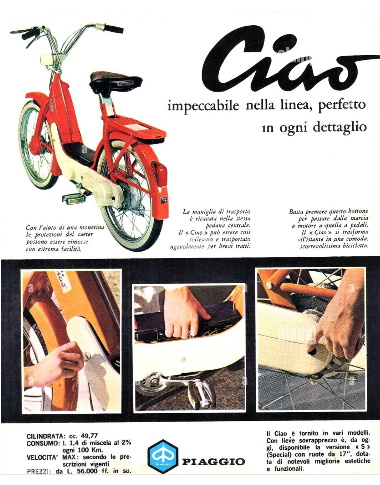
![]() Production of the Ciao begins in October XNUMX and ends in December XNUMX. During this period, more than XNUMX million vehicles were sold. It is the most sold Italian moped in the world.
Production of the Ciao begins in October XNUMX and ends in December XNUMX. During this period, more than XNUMX million vehicles were sold. It is the most sold Italian moped in the world.
![]() When French youth had the Mobylette or the Peugeot XNUMX, the Italian youth rode the Ciao, which allowed the teenagers of the XNUMXs and XNUMXs to realize their desires for autonomy.
When French youth had the Mobylette or the Peugeot XNUMX, the Italian youth rode the Ciao, which allowed the teenagers of the XNUMXs and XNUMXs to realize their desires for autonomy.
![]() It should be noted that it was rather the girls who opted for this machine, as in France with the XNUMX and XNUMX. The female audience doesn’t care much about the lack of a speedometer.
It should be noted that it was rather the girls who opted for this machine, as in France with the XNUMX and XNUMX. The female audience doesn’t care much about the lack of a speedometer.
![]() It is a XNUMX cc moped, therefore usable from XNUMX years, intended to motorize the whole family even in deep Italy, where the road is not necessarily tarred. Less expensive, lighter and more stable thanks to its large wheels than the scooter but not very powerful, it is also suitable for city dwellers. Its performance is halfway between the Solex and the Mobylette. His concept too. The little petrolette of Piaggio has a right to a XNUMXcc single but this one is anemic though some are giving it a go-forward. This is quite sufficient to suit the cycle part which is in the featherweight.
It is a XNUMX cc moped, therefore usable from XNUMX years, intended to motorize the whole family even in deep Italy, where the road is not necessarily tarred. Less expensive, lighter and more stable thanks to its large wheels than the scooter but not very powerful, it is also suitable for city dwellers. Its performance is halfway between the Solex and the Mobylette. His concept too. The little petrolette of Piaggio has a right to a XNUMXcc single but this one is anemic though some are giving it a go-forward. This is quite sufficient to suit the cycle part which is in the featherweight.
![]() In France, the Ciao has managed to make a small place for itself between the Motobécane and Peugeot . He is found more to the south of the Loire than to the north and his slender appearance does not necessarily please the boys of those years who do not find him manly enough. As in Italy, it is above all girls who adopt the Piaggio . They don’t care about the absence of a speedometer and that the Piaggio do less "motorcycling" than Mopeds or Peugeot . What they like is the nice little high-pitched headlight and the relaxed driving position.
In France, the Ciao has managed to make a small place for itself between the Motobécane and Peugeot . He is found more to the south of the Loire than to the north and his slender appearance does not necessarily please the boys of those years who do not find him manly enough. As in Italy, it is above all girls who adopt the Piaggio . They don’t care about the absence of a speedometer and that the Piaggio do less "motorcycling" than Mopeds or Peugeot . What they like is the nice little high-pitched headlight and the relaxed driving position.
![]() Finally defeated par the return of the scooter in the fifties, the small Piaggio left a legacy behind. It is undoubtedly at the origin of the particular fondness of the Italians for scooters with large wheels.
Finally defeated par the return of the scooter in the fifties, the small Piaggio left a legacy behind. It is undoubtedly at the origin of the particular fondness of the Italians for scooters with large wheels.
![]() This small universal machine aroused the enthusiasm of the public but also that of the equipment manufacturers. Its anemic engine automatically asked to be inflated and the Italian engineers of the teams Polini, Malossi and others had a blast. There are very many competition parts for the Ciao, which range from the simple pulley of different diameter to the larger cylinder piston, to the complete factory engine, to the crankcase, these parts. ¨ces being manufactured mainly par Malossi , Pinasco, RMS, Polini or even Simonini.
This small universal machine aroused the enthusiasm of the public but also that of the equipment manufacturers. Its anemic engine automatically asked to be inflated and the Italian engineers of the teams Polini, Malossi and others had a blast. There are very many competition parts for the Ciao, which range from the simple pulley of different diameter to the larger cylinder piston, to the complete factory engine, to the crankcase, these parts. ¨ces being manufactured mainly par Malossi , Pinasco, RMS, Polini or even Simonini.
![]() In the history of the moped, no model has ever known (and probably never will know) the extreme popularity of the Piaggio Ciao XNUMX from the Italians.
In the history of the moped, no model has ever known (and probably never will know) the extreme popularity of the Piaggio Ciao XNUMX from the Italians.
![]() From its first commercialization in XNUMX until its last year of production in XNUMX, it sold more than three and a half million copies.
From its first commercialization in XNUMX until its last year of production in XNUMX, it sold more than three and a half million copies.
![]() A phenomenal success that could be compared to that of the
A phenomenal success that could be compared to that of the ![]() Peugeot XNUMX
Peugeot XNUMX ![]()
![]() with the French. It was initially commercially successful with women due to its lightness and slender line before arousing the enthusiasm of eager young men. of custom ization as the model readily lends itself to tuning.
with the French. It was initially commercially successful with women due to its lightness and slender line before arousing the enthusiasm of eager young men. of custom ization as the model readily lends itself to tuning.
![]() A bike with a motor is the first thought that comes to mind when you see a Piaggio Ciao XNUMX. Never has a cycle part borne its name so well. The wheels are unmistakably reminiscent of those of bicycles and it is fitted with a crankset which can be detached from the motor system. The first series even had a front caliper bicycle brake!
A bike with a motor is the first thought that comes to mind when you see a Piaggio Ciao XNUMX. Never has a cycle part borne its name so well. The wheels are unmistakably reminiscent of those of bicycles and it is fitted with a crankset which can be detached from the motor system. The first series even had a front caliper bicycle brake!
![]() A rear rack that has accommodated generations of buttocks, a small front headlight and no speedometer. Finally, what distinguishes the Piaggio Ciao XNUMX of a simple bike is that it has a XNUMX cc engine.
A rear rack that has accommodated generations of buttocks, a small front headlight and no speedometer. Finally, what distinguishes the Piaggio Ciao XNUMX of a simple bike is that it has a XNUMX cc engine.
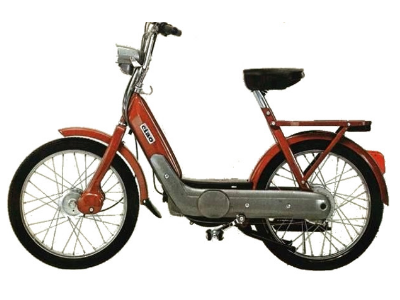
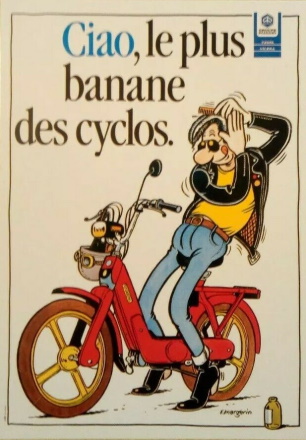
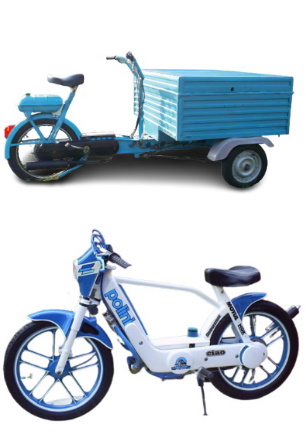
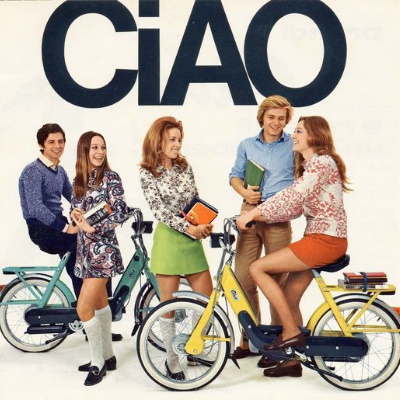
![]() The XNUMX Magazine Factory the Mag devoted an article to the moped
The XNUMX Magazine Factory the Mag devoted an article to the moped ![]() Piaggio Ciao.
Piaggio Ciao.
![]() XNUMX% of products shown as in stock actually are!
XNUMX% of products shown as in stock actually are!